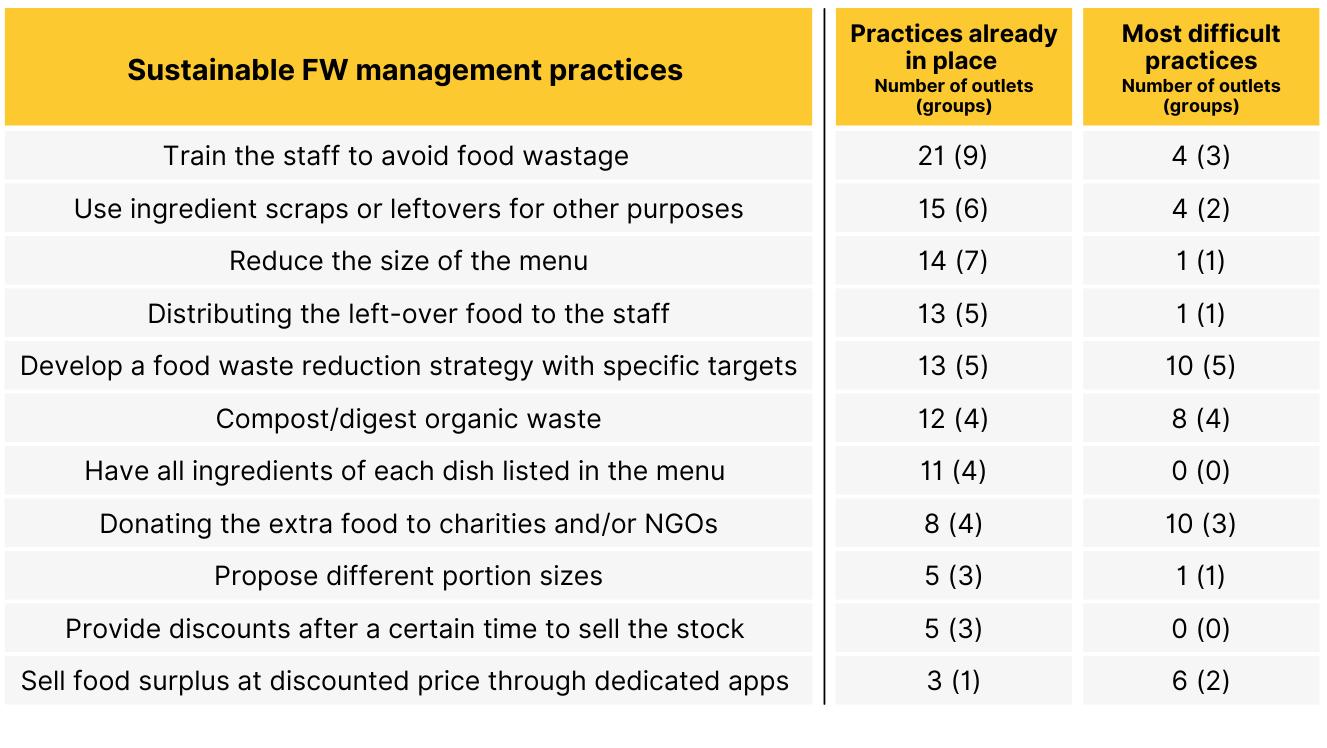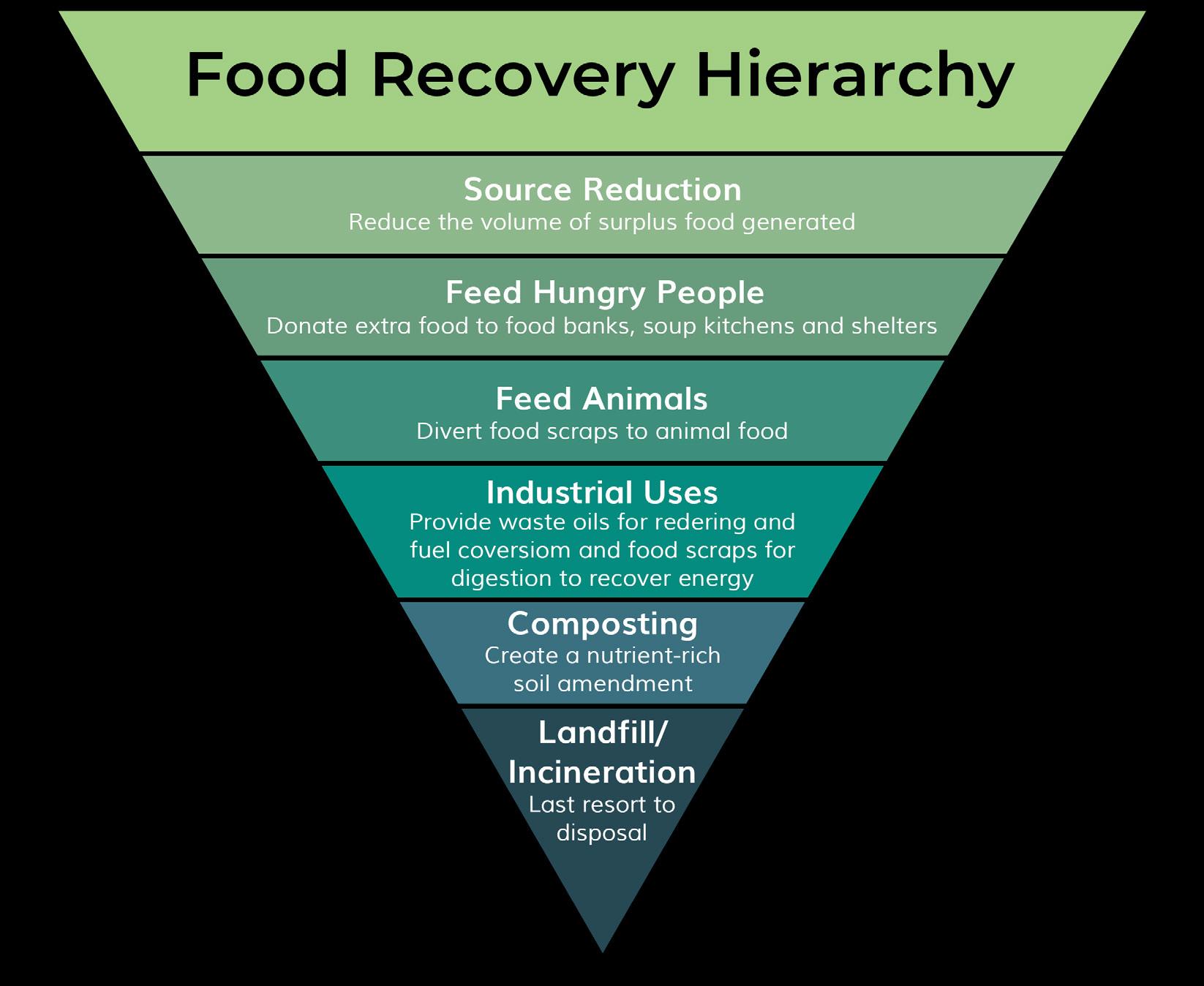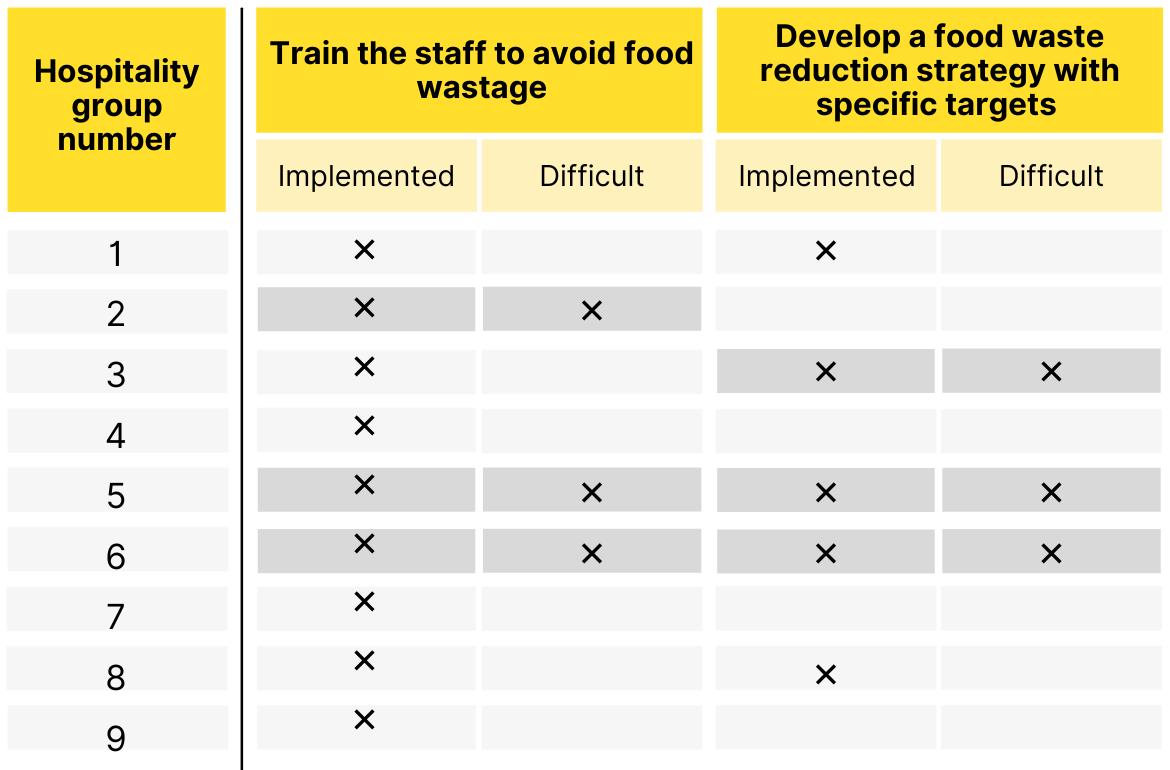
14 minute read
current practices and main challenges
from Waste Deep: An Exploratory Study of the Waste Generated by the Hospitality Industry in Hong Kong
3. FOOD WASTE REDUCTION MEASURES: CURRENT PRACTICES AND MAIN CHALLENGES
While the previous sections explored waste management practices for SFP items and food waste, this section focuses specifically on the practices of our respondents to reduce food waste generation, before they have to dispose of the waste. In order to assess the difficulty of these practices, we will compare them with the practices that our respondents think are the most difficult to implement. Insights about the main barriers of implementation were also gathered in order to understand why these practices were difficult to implement, despite the fact that they are already in place. Finally, we also tried to understand how the different outlets and groups overcome these barriers.
Advertisement
Table 9: Sustainable practices judged most difficult and practices already in place (out of 21 outlets)

In accordance with the profile of our respondents, outlets in our sample had, on average, 5.7 out of the 11 sustainable practices proposed in place. Table 9 above shows the distribution of the practices per outlet number and per group, and compares them with the practices that outlets and groups found most difficult to implement.
3.1 Low hanging fruits in food waste reduction
From Table 9 above, by focusing on the practices that outlets have in place but don’t find difficult to implement, one can deduce the easiest measures to implement at the outlets, but also the most frequent ones in our sample.
Regarding waste reduction, all outlets/groups seemed to agree that training was an effective way to reduce food waste generation, as well as to help shape staff’s habits. According to the interviews conducted with staff and management teams, effective training needs to be regular, includes daily reminders, and aims to explain instead of just prescribe. Monitoring was a crucial aspect to change the habits and attitudes of staff: one chef of a major group further mentioned that if monitoring on a senior level was lacking, then so would the execution of sustainability rules. The goal of monitoring was not to control every single movement of staff but to briefly look over how staff prepared food and correcting the behaviour through daily or regular briefings. One outlet mentioned that they held regular communication meetings with their team to demonstrate the current amount of food waste measured.
Additional to the training, 15 out of 21 outlets (6 groups) mentioned that they make use of ingredient scraps or leftovers for other purposes like vegetable trimmings to make broths or soups or potato skins to make snacks. Some outlets actually include this dimension in the training of their kitchen staff. At one outlet, an event night was organised in which the head chef prepared dishes solely using scraps and leftovers, which served as an educational occasion for guests and staff alike, and was very appreciated on both sides. Furthermore, establishments with multiple outlets at one location mentioned sharing unused ingredients with each other. For this particular outlet, the management team mentioned that it was particularly relevant

for their exclusive fine-dining restaurants, as standards in such operations often require that only a small part of the ingredients is used: “[...] let's say we cannot use all of it in our fine dining restaurant, then certain parts of fish for example will be used in another restaurant or downstairs and in [our bar] or in the canteen,” mentioned a staff member.
Optimizing and improving the menu was also widely used in our sample as a way to generate less food waste in the kitchen. 14 out of 21 outlets (7 groups) adopted a smaller and well-curated menu to fit the actual needs of guests. One outlet in particular even adopted a “running out policy”, meaning that the outlet ordered just enough produce and ingredients, effectively deliberately putting a limit on the quantity of each menu choice. In doing so, the outlet is ready to compromise on guests' satisfaction by accepting the risk that some guests might have to reconsider their choices when ordering their meals. This is why, in this outlet, the staff is trained to advise guests on which dish would be closest to their taste or as enjoyable for them as the one they had chosen in the first place. 11 outlets (4 groups) also had all ingredients of each dish listed in the menu. Hence, guests would know what to expect from each menu choice and tell the waiter to leave out ingredients they do not like.
Besides providing training and making use of leftover ingredient scraps, another reason for an establishment’s low food waste was, according to a member of staff, the lack of extra garnishes plated on the dish. Tapping into his previous experience, the waiter mentioned that he used to work at a restaurant where garnishes such as pre-cut carrot swans were displayed in a display area before being used as garnishes for various dishes. Most of the carrot swans were not eaten, since according to the member of staff, no staff member went out of their way to inform guests that the carrot swans were indeed edible.

The garnishes were laid out in a display area which promoted reminiscence of decorations and thus lost their first purpose which is to be eaten. Garnishes are there to add to the plate colour and texture, and should represent the ingredients that have been incorporated in the dish. If garnishes are not well-chosen such as lemon slices in a dish that does not incorporate lemons otherwise or - in this case - carrot swans for a multitude of different dishes, garnishes become waste.42 For all these reasons, many reports promoting food waste reduction are proponents of a no-garnish policy. 43
3.2 The last mile: most difficult food waste reduction measures
In Table 9, among the measures that were deemed most difficult to implement by our respondents, three stood out. They can be compared with their respective position on the “Food Recovery Hierarchy” in Figure 11 below.
First, “Developing a food waste reduction strategy with specific targets” was a major challenge for 10 out of 21 outlets (5 groups). Since measuring food waste is one of the enablers of establishing a coherent food waste reduction strategy, we could expect outlets who measured food waste to find it less hard to develop a food waste reduction strategy. This is verified in our sample, where none of the 3 groups who measured food waste in their operations mentioned “Developing a food waste reduction strategy with specific targets” as one of three biggest barriers to implementing better food waste management. We can then expect that, for the 6 outlets that did not measure food waste, it would be more difficult to establish a baseline, which is crucial to establishing a reduction strategy.
The difficulty of implementing a food reduction strategy can also be due to the fact that it requires a holistic view and systemic changes to be implemented throughout all the aspects of the operations. One particular outlet, which was attached to a hotel, mentioned that, if changes to the waste management system were to happen, they would have to happen throughout the entire building. Once again, owners and franchise operators were perceived as enablers, since a restaurant manager could not do much without asking the owner. During the interviews with the staff for this particular outlet, the staff seemed reluctant to impulse change due to it seeming like an insignificant action or due to not wanting to disturb

the hotel management and the current practices. During other interviews, factors like bureaucracy, insufficient communication, and high setup costs impeded independent changes to happen, which was an opinion mentioned by many respondents when discussing implementing systemic changes.
Second, “Compost/digest organic waste”, which was a challenge for 8 out of 21 outlets (4 groups). This difficulty to implement this method can be linked to several barriers mentioned in Section 2.3. Among the 8 outlets who said that composting or digesting was a challenge: - 5 mentioned as a barrier that better food waste management methods were too costly (e.g. hiring external contractors, buying the equipment) - 5 mentioned a lack of space, and - 4 cited “Little to no Government/external initiatives or support” as a main barrier.
Figure 11: Food waste recovery hierarchy

Source: The United States Environmental Protection Agency

As such, hospitality businesses who find composting and digesting particularly difficult to implement, seem to be constrained by several factors such as cost, space and would hope for external support if they were to implement such food waste management methods.
Third, “Donating the extra food to charities and/or NGOs” was a major challenge for 10 out of 21 outlets (3 groups). Food donation, almost at the top of the waste hierarchy, can prevent waste generation, support the local community and reduce waste management costs.44
During our interviews, several reasons were evoked by the respondents for finding food donations difficult. One outlet for example was unsure on what to donate since they had a running out policy in place, meaning that only scraps and trimmings were left behind, not full meals. “[...] what would we donate?,” asked an operator in an interview, “Because we don’t have so much food waste. [...] either it’s, you know, the cuts or whatever that goes into the food digester. But in terms of leftover food, we don’t overproduce”.
Further barriers hindering food donations were mentioned in the interview, such as donors fearing being held liable if something happened to people who consumed the donated food. This can be due to the fact that, in Hong Kong, there is no so-called “Good Samaritan Law” to exempt food donors from product liability.45 Despite local food banks signing bilateral agreements with donors to compensate for the lack of such regulation, donors might not be aware of that fact and be discouraged to donate. According to the additonal interview between GREEN Hospitality and the food bank representative mentioned earlier, he also cited as a factor the relative novelty of the practice of food banking in Hong Kong, compared with other places like France where there is a higher priority placed on food issues in the policy agenda by the French Government.46
Finally, another group (representing 3 outlets) also mentioned “Waste segregation due to lack of recycling options” among the most difficult practices in addition to the proposed answers. This challenge can be linked to several of the barriers that have been identified in Section 2.3, namely the lack of waste management infrastructure at the city level, “Little to no Government/external initiatives or support” and the lack of space within the restaurant.

3.3 Long-hanging fruits: what it takes for systemic and durable changes
Interestingly, for a few food reduction measures, respondents mentioned that they had already implemented them, but they also appeared to be the most difficult measures to implement. If one can think that different outlets could implement and find difficult different measures, thus not necessarily leading to an overlap of the measures for the same outlets, a closer look at the distribution of the measures show that, for two measures in particular, it is often the same outlets/groups who cite them as both something they have been implementing and as one of the three most difficult measures to implement. The two measures were “Develop a food waste reduction strategy with specific targets” and “Train the staff to avoid food wastage” and Table 10 below displays the distribution of these two measures per group:
Table 10: Overlaps between implemented and most difficult food waste reduction measures


This overlap between implemened and most difficult measures could be due to the fact that both are long-term, ever evolving and require systemic thinking and change. If training was widely adopted by outlets, one dimension of training was particularly challenging for staff and management teams: changing guests habits. Indeed, in addition to the proposed food reduction measures, one group (representing 5 outlets) mentioned “changing clientele mentality on food consumption (finishing fully the dish or eating all garnishes not only the animal protein)” as one of the three most difficult measures to implement. This was a recurring concern for staff during the interviews. Even if a restaurant owner mentioned that, during the training, waiters were encouraged to let the guests know if they think they have ordered too much or too little, a waiter wished for additional training on how to deal with guests who wasted a lot and refused to take the leftover food home with them: “[...] most of these guests are very stubborn in their ways. They aren’t really thinking about the environment and stuff when they’re having a good time with like six of their friends, right?” Dining out is seen as an enjoyable occasion and dimming that joyous element is for some outlets untrodden terrain. A “Love food, hate waste” consumer research study found out that the majority of respondents did not want to think of food waste when dining out, which is reiterated by staff who did not know how to encourage guests to order less or take-away leftovers.
The difficulty of the second measure, “Develop a food waste reduction strategy with specific targets”, has been touched upon during the interviews:
restaurant owners and managers saw it as a trial-and-error approach
that needed constant readjustment and improvement, hence the difficulty to maintain it in the long term, even for the outlets considering it as a measure already in place.
The different interaction with the staff and the management teams revealed that, for all the outlets in our sample that had a strong focus on sustainability in their operations, there was always one passionate person
who would be pushing for a sustainability approach not only regarding
food waste, but also all sustainability aspects in the outlet’s operations, like procurement, menus, and even the furniture used in the outlet. This person, who we called “Sustainability Champion” was not necessarily the head of sustainability of the hospitality groups: we observed that sometimes that person could be the owner, the director of one of the restaurants of the group, or a Chef. Having a sustainability champion makes for clear goals and directions and inspires other members of the team to follow their vision.

The champion was most of the time not appointed for the specific task of improving sustainability practices, but was a role an individual who is passionate about the environment, educated about sustainability and forward-thinking took over. In a qualitative study conducted by the Natural Resources Institute in Finland and published in 2016, one reason for food waste generation was poor management practices. Similar to the “Sustainability Champion”, the managerial work described in the study had an influence over kitchen operations, processes and activities.47 “A manager has to be able to
motivate, encourage and give instructions to staff so that they can carry
out their duties professionally and to the best of their abilities” (Heikkilä et al. 2016, 449). Likewise, “Sustainability Champions” are responsible for inspiring and educating staff, as well as implementing an environmentallyconscious workplace.
For such a work environment, we observed that no one was fully responsible for waste management but that the “Sustainability Champions” were able to leverage teamwork between the kitchen, waiters and owners in order to reduce food waste. For such establishments, it appeared crucial to create an environment for staff to discuss environmental issues and raise awareness of sustainability practices in order for the team to grow and learn. If the “Sustainability Champion” could be the impetus of such initiatives, the responsibility of creating such a work environment
also falls on owners, managers and operators to continuously work on
the group mentality by organising event nights, training, and educational events such as farm visits, food bank visits, or other activities involving both the staff and the community. According to our respondents, if a group has a common goal and believes in the same philosophy, then changes will be all the more easier to implement. When an outlet plans to move to a more transparent waste management system, staff would feel valued because they are well-informed and are given the opportunity to contribute to the discussion about an aspect of the operations that will affect their work. An inclusive work environment and a philosophy people can support could increase the loyalty of staff towards the establishment and thus reduce staff turnover. “[The philosophy is] part of why I am here, essentially,” mentioned a staff member in an interview.








